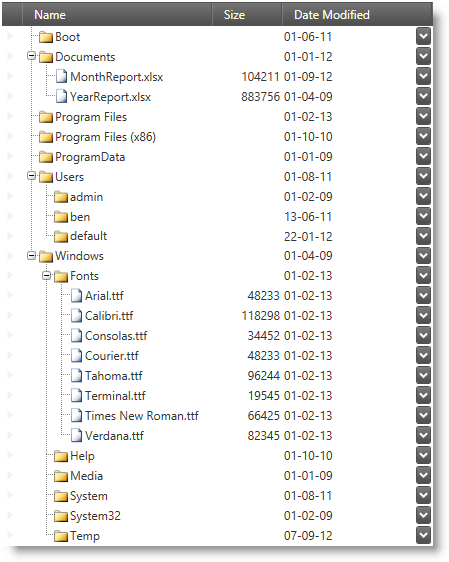
This topic explains the features supported by the control from developer perspective.
The following table lists the concept and topics required as a prerequisite to understanding this topic.
This topic contains the following sections:
The xamTreeGrid is a control from the Data Presenter family which arranges data in a tree grid layout. Essentially the control is a xamDataPresenter that implements a single view (a TreeView) which cannot by dynamically switched.
The xamTreeGrid control is similar to the xamDataGrid in many aspects like data binding, field definition, events, commanding etc. This set of topics will describe the differences you need to know comparing to the xamDataGrid. This said it is a good idea to familiarize yourself with the concept and topics listed in the "Required Background" section.
Like the xamDataGrid, the xamTreeGrid has a view extending from the GridViewBase and because of this it lays out data out in columns and rows. There is an important addition however – one field is designated as the tree field. This is a field which contains a tree representation of the hierarchical data bound to the control. You have the ability to browse thought the nested records' levels by expanding and collapsing them using the designated expansion indicators.
The following screenshot shows the xamTreeGrid control displaying hierarchical structure of records with the tree positioned in the "Name" field. The "Name" field in this example is using a custom template for the TreeCellValuePresenter which displays an image for each record:

The following table summarizes the main features of the xamTreeGrid control in addition to the features supported by the xamDataGrid control. More details are available after the summary table.
You can specify the field in which the tree will be displayed and also position the tree on the left or on the right side of the field using the xamTreeGrid’s FlowDirection property.
Related Topic:
The control supports expanding and collapsing of nested records using expansion indicators. The initial state of the expansion indicators can be configured.
Related Topic:
The control supports cross-level selection.
Related Topic:
The control supports multi-level record filtering. You can configure how the control displays records which do not match the filtering criteria.
Related Topic:
The control supports summaries for each nested record level. You can specify the calculators for each field.
Related Topic:
As any other Data Presenter control, the xamTreeGrid support data exporting to popular Microsoft® Excel® file format and Word® file format.
Related Topics:
The following topics provide additional information related to this topic.